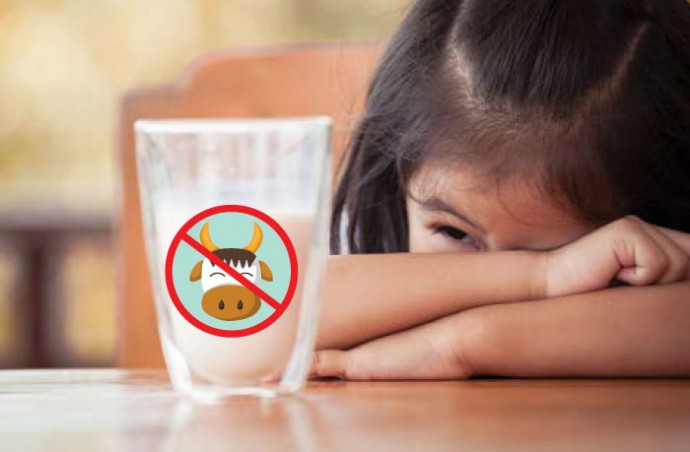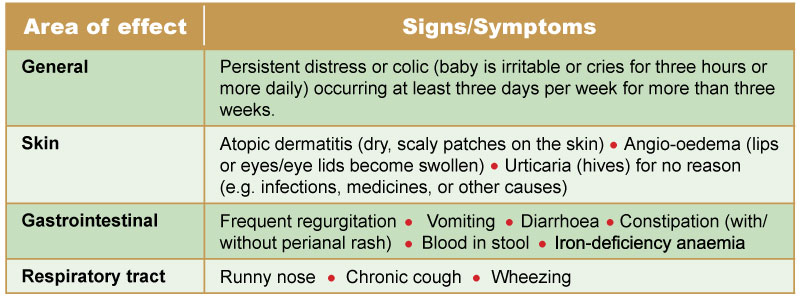Cow’s Milk Protein Allergy, or CMPA, is a common food allergy among young children and infants with a prevalence that is comparable to that in Western countries.
It happens when an infant or child’s body responds to cow’s milk protein with a hypersensitive allergic reaction. It is estimated that between 2%-7.5% of infants suffer from CMPA. Even exclusively breastfed infants who have CMPA can be affected as cow’s milk protein may be transmitted via breast milk – in such a situation, the mother would have to eliminate cow’s milk from her diet.
While CMPA can develop from the neonatal period, it tends to peak by the first year and usually resolves itself by around 3-4 years of age. The rate that your baby outgrows CMPA is roughly between 45%-50% for one-year-olds, 60%-75% for two-year-olds, and 85%-90% for three-year-olds. However, there are cases where CMPA persists into adolescence.
Identifying CMPA
As the signs and symptoms associated with CMPA can be unclear at times, you should keep a close eye on your infant. Here’s what you need to stay alert for:
Diagnosing CMPA
The most commonly used method to reliably diagnose CMPA is by eliminating foods that contain cow’s milk protein from your infant’s diet. If he is exclusively breastfed and has not started complementary feeding yet, then the elimination diet would also apply to the breastfeeding mother.
This would remove all sources of cows’ milk protein in her diet, in order to prevent the protein from any cow’s milk in her diet from being transferred to baby via her breast milk. If his symptoms have improved, then foods with cow’s milk protein can be re-introduced to see if a reaction re-occurs.
This should only be carried out under the guidance of healthcare professionals as proper knowledge of how to achieve the elimination diet is critical for success. They will be better able to advise you on important points such as accidental exposure and cross-contamination (e.g. shared utensils, cups, or plates), and also advise you on what to watch out for when shopping for food products.
Did you know?
Foods that contain cows’ milk include (but are not limited to) items such as butter, buttermilk, cheese, cream cheese, lactose, milk (evaporated, powder, condensed), cream, sour cream, ghee, curd, and also food products that contain whey or whey solids, milk solids, hydrolysed whey, whey powder, or yoghurt. As the food manufacturers may change the ingredients they use at any time, make it a point to check the ingredients list before you buy any food product.
As dairy foods are one of the best sources for calcium, you will need to eat other food that are rich in calcium such as canned sardines, anchovies, beans and bean products (e.g. yellow dhal), tofu, tempeh (fermented soybeans), and vegetables such as spinach, watercress, mustard leaves, cekur manis, tapioca leaves, kailan and broccoli. You can also opt for breakfast cereals, biscuits and even rice that are enriched with calcium. If you want to take supplements instead, do check with your healthcare professional to see what he or she recommends.
Clinical Tests
Alternatively, your doctor may opt to do clinical tests instead.
- Blood Test (radioallergosorbent test, or RAST) – this test is used to look for allergens and can be used to check for milk protein antibodies known as Immunoglobulin E (IgE). However, if your infant suffers from a non-IgE CMPA, this test would give a negative result.
- Skin Prick Test (SPT) – a small droplet with the suspected allergen is placed on the skin which is then scratched or pricked with a needle. If a wheal appears, i.e. the skin turns red with a raised itchy area, this is a positive reaction and it means that your infant is likely to be allergic to that allergen when correlated to a positive clinical history.
Do note that it is possible for allergies to appear as either just one particular type of allergy, or as a mixture of IgE and non-IgE allergies.
Anaphylaxis
You may have heard of anaphylaxis, or anaphylactic shock. It is a situation where the patient’s body has a severe, and quite possibly life-threatening, reaction to a specific allergen, including but not limited to CMPA. This condition is not exclusively tied to CMPA.
Luckily, not all CMPA patients will suffer from anaphylaxis. However, as many as 9% of CMPA patients may exhibit anaphylaxis, so make sure to keep an eye on your infant or toddler, especially if you already suspect that he may have CMPA. If his body reacts to the allergen (in this case, cow’s milk protein) with a severe allergic reaction, it should be treated as a medical emergency.
These allergic reactions tend to be severe and immediate, and can affect more than one organ. It is a serious and potentially life-threatening symptom as it could cause the airway to narrow or swell shut, or even lead to a drop in blood pressure that can lead to shock.
An educational contribution by Malaysian Paediatric Association










Comments